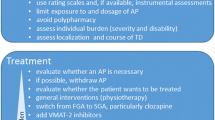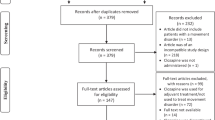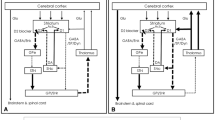Abstract
Objective
The aim was testing whether atypical antipsychotics (versus typicals) were associated with less risk of tardive dyskinesia (TD) in 516 severely mentally ill patients.
Methods
The sample included 11% (57/516) with no exposure before current treatment with atypicals; 9% (48/516) with prior and current treatment with atypicals but no exposure to typicals; 18% (94/516) with lifetime exposure to typicals for <5 years (plus atypicals); and 62% (317/516) with lifetime exposure to typicals for ≥5 years (plus atypicals). The Abnormal Involuntary Movement Scale (AIMS) was used to assess dyskinetic movements. Following Schooler and Kane’s criteria TD was considered present when mild movements were present in at least two body areas or moderate movements were present in at least one body area.
Results
TD prevalences were 5% (3/57) in previously naïve patients, 19% (9/48) after exposure only to atypicals, 19% (18/94) after typical exposure of <5 years, and 42% (132/317) after typical exposure of ≥5 years. There was no significant effect comparing those taking only atypicals to those exposed to typicals for <5 years (OR = 1.0, CI 0.42–2.5).
Conclusion
This study is limited by the naturalistic design, the relatively small samples in the first two groups, the lack of information on the duration of the atypicals and their relatively recent introduction to the market (ziprasidone and aripiprazole were introduced to the market in the middle of the study). This study raises the question that new TD studies need to establish whether decades of treatment with atypical antipsychotics make a difference.
Similar content being viewed by others
References
Correll CU, Leucht S, Kane JM (2004) Lower risk for tardive dyskinesia associated with second-generation antipsychotics: A systematic review of 1-year studies. Am J Psychiatry 161:414–425
de Leon J, Susce MT, Pan RM, Fairchild M, Koch W, Wedlund PJ (2005) Polymorphic variations in GSTM1, GSTT1, PgP, CYP2D6, CYP3A5, and dopamine D2 and D3 receptors and their association with tardive dyskinesia in severe mental illness. J Clin Psychopharmacol 25:448–456
Dolder CR, Jeste DV (2003) Incidence of tardive dyskinesia with typical versus atypical antipsychotics in very high risk patients. Biol Psychiatry 53:1142–1145
Lee PE, Sykora K, Gill S, Mamdani M, Marras C, Anderson GM, Shulman KI, Stukel T, Normand S-L, Rochon PA (2005) Antipsychotic medications and drug-induced movement disorders other than parkinsonism: a population-based cohort study in older adults. J Am Geriatr Soc 53:1374–1379
Leucht S, Pitschel-Walz G, Abraham D, Kissling W (1999) Efficacy and extrapyramidal side-effects of new antipsychotics olanzapine, quetiapine, risperidone, and sertrindole compared to conventional antipsychotics and placebo. A meta-analysis of randomized controlled trails. Schizophr Res 35:51–68
Nasrallah HA (2006) Focus on lower risk of tardive dyskinesia with atypical antipsychotics. Ann Clin Psychiatry 18:57–62
Markham-Abedi C, McNeely C, de Leon J (2006) Ziprasidone-induced catatonia symptoms (letter). J Neuropsychiatr Clinical Neurosci (in press)
Pierre JM (2006) Extrapyramidal symptoms with atypical antipsychotics. Incidence, prevention and management. Drug Safety 28:191–208
Rochon PA, Stukel TA, Sykora K, Gill S, Garfinkel S, Anderson GM, Normand SL, Mamdani M, Lee PE, Li P, Bronskill SE, Marras C, Gurwitz JH (2005) Atypical antipsychotics and parkinsonism. Arch Intern Med 165:1882–1888
Schooler NR, Kane JM (1982) Research diagnoses for tardive dyskinesia (letter). Arch Gen Psychiatry 39:486–487
Acknowledgements
These analyses were conducted without external funding support. Francisco J. Diaz, Ph.D., from the Department of Statistics, Universidad Nacional, Medellin, Colombia, helped to calculate the prevalences adjusted for confounders described in Table 1. The subject recruitment and genetic testing for this sample was conducted for a pharmacogenetic study that was supported by several sources: a researcher-initiated grant from the Eli Lilly Research Foundation to Jose de Leon, M.D. (24% of direct costs), a NARSAD Independent Award to Jose de Leon, M.D. (11% of direct costs), internal funding (37% of direct costs), and finally by Roche Molecular Systems, Inc., which provided free genotyping and laboratory supplies (equivalent to 28% of direct costs). Besides this support, in the past three years Dr. de Leon has 1) been on the advisory board of Bristol-Myers Squibb and Roche Molecular Systems, Inc.; 2) received researcher-initiated grants from Roche Molecular Systems, Inc. and Eli Lilly; and 3) lectured supported by Eli Lilly (once), Bristol-Myers Squibb (once) and by Roche Molecular Systems, Inc. (5 times). The author thanks Lorraine Maw, M.A., for editorial assistance. A shorter preliminary version of this article was presented as an abstract at the 61st Annual Meeting of the Society of Biological Psychiatry, Toronto, Ontario, Canada, May 18–20, 2006.
Author information
Authors and Affiliations
Corresponding author
Rights and permissions
About this article
Cite this article
de Leon, J. The effect of atypical versus typical antipsychotics on tardive dyskinesia. Eur Arch Psychiatry Clin Neurosci 257, 169–172 (2007). https://doi.org/10.1007/s00406-006-0705-z
Received:
Accepted:
Published:
Issue Date:
DOI: https://doi.org/10.1007/s00406-006-0705-z




